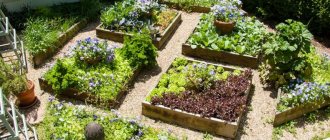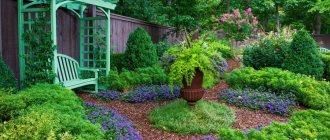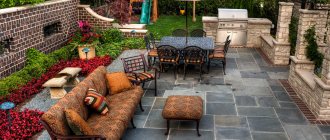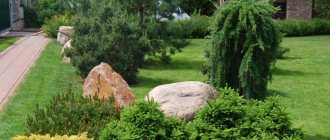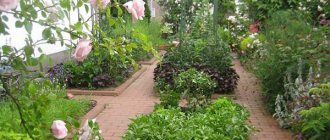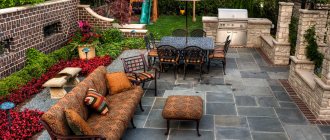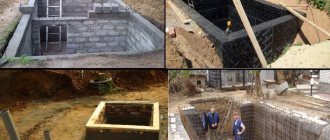Most people are attracted to real estate outside the city because there is clean air, beautiful scenery, and the absence of dust, noise and city bustle. Owners of country houses are trying not only to buy a house in the suburbs, but also to equip it in such a way that outdoor recreation is truly as comfortable and cozy as possible. And for this you need to take a responsible approach to planning landscape design, especially in front of the house.
Flowerbeds
Flower beds fit harmoniously into the landscape of the garden plot and the local area of the cottage. They are used to decorate recreation areas, garden ponds and, of course, the area at the entrance. There are several options for using plants for the entrance space:
- Decorative hedges made of bushy, lushly flowering plants near a gate or fence. They get along equally well next to a picket fence or metal forging.
- Raised flower beds framing garden paths from the gate to the door itself.
- Spot flower beds near the porch.
Main landscape objects
Some nuances in the landscape can be thought out during the process of creating it, but the main details, which will later be difficult to change or move, should be planned in advance. For example, if the project has a stone gazebo, it is impossible to change its location upon completion of construction.
But it’s never too late to make adjustments to the decorative design, since an interesting idea for the design of the site may come when the overall picture of the landscape begins to emerge.
Entrance area
The front area of a private house (part of the courtyard area, clearly visible from the street), is the “face” of the estate, so its design requires special attention. Here you should take into account the practicality of the entrance group, as well as think through the design of the front garden and yard down to the smallest detail.
Plants in the front garden should be combined with the style of the residential building and be aesthetically attractive. If the owners are too busy to devote much time to maintaining decorative compositions, they should choose unpretentious but effective vegetation.
In this situation, coniferous plants will help out, most species of which easily tolerate arid soils and can grow on rocky and sandy soil. In addition, they do not shed their needles for the winter (except for larches), so they are elegant all year round.
Yard area
Improper planning of the yard area can create discomfort while using it. The area in front of the porch must be free so that a person leaving the house can cross the yard without obstacles and get to the desired part of the estate.
It is most convenient to do extensive paving. A small courtyard is usually completely laid out with tiles or paving stones, and only a narrow strip of land is left along the fence for planting flower beds.
Composition with thujas along the fence
In the spacious yard it is possible to allocate a sufficient part of the land for decorative compositions. In this case, various hydraulic structures are created next to the flower beds, and small architectural structures are erected.
No matter how much you would like to design the yard as a purely decorative area, you should not lose sight of the practical side. It must provide parking for vehicles and a garage. Of course, it is better if these objects are located in another part of the site, for example, in the backyard.
Resting-place
Living in a private home offers a unique opportunity to spend more time outdoors. So that leisure time is not limited to banal gatherings on the porch, it is important to organize a full-fledged place of relaxation, and, if necessary, arrange several areas according to interests: for privacy, for noisy parties, for tea parties with the family.
Front garden at the entrance
A small area between the road and the gate can also serve a decorative purpose. Build a small picket fence, plant a few shrubs, add a couple of flower beds, and the surrounding area will become the object of attention of passers-by.
The style of the front garden is traditionally supported by the architectural features of the house.
The exterior style does not always require lush flower beds around. Sometimes it is enough to decorate the fence area with a neat lawn. A narrow winding path will help to visually increase the area of the front garden.
Path to the house
The only mandatory requirement for the track is all-weather. Otherwise, site owners can feel free to be creative. You can experiment with the flooring material, its shape and size. For the path leading to the house, paving slabs, stone, brick, sawn wood and concrete slabs in combination with the greenery of the lawn are suitable.
It is customary to make the width of the front path wider than walking garden paths.
This technique visually expands the space in front of the house, making the area more comfortable and functional.
Gates
What everyone will definitely pay attention to is the gate. They must play in the same ensemble with other elements of the site, but at the same time be as functional as possible. It is important to provide a swing or sliding structure for vehicle entry and a gate for pedestrian entry.
Decorative fence
The gate should be complemented by a fence designed in the same style. If the fence conflicts with the gate or exterior elements, the impression of the entire entrance area will be spoiled.
- For metal gates, a wrought iron fence with brick or stone supports is suitable.
- For areas where natural materials and colors predominate in the exterior decoration of the house, it is worth choosing laconic wood-look blinds.
Lighting as decor
Landscape lighting solves functional and decorative problems in equal measure. It is important to illuminate the entrance, paths and porch for a comfortable stay on the site in the evening, as well as highlight decorative elements.
Several techniques are used for lighting design of the entrance area.
- LED lighting integrated into garden steps and front porch.
- Bollards and floor lamps for framing paths.
- Classic lanterns to decorate the entrance to the house.
When choosing lighting, give preference to diffused light lamps; they will complement the natural landscape, but will not dazzle your eyes.
Garden plot design ideas
The area around the house primarily separates private properties from street ones, and can also decorate the housing itself. Today, the arrangement of household plots is not a particular problem; there are many interesting proposals and ideas in this regard. For example, the simplest and most common way is to decorate the area with flower beds and create a hedge. Fountains in front of the house or artificial ponds, decoration around the home area with various figures, statues or other unusual details are becoming increasingly popular.
An integral part of any private home are gazebos and specially designated recreation areas. The choice is huge, it all depends on the taste preferences of the owner and, accordingly, his financial capabilities.
In this case, the main thing to take into account is an important point - the choice of landscape compositions must necessarily correspond to the style and architectural character of the building.
Flower garden design idea
Parking area
Most modern suburban areas are equipped with a system of automatically opening gates. Guests do not linger at the entrance, but immediately drive into the territory. The first thing that catches your eye in this case is the parking area. In small areas it often connects the entrance gate and porch.
To design a parking lot, concrete, crushed stone, and paving slabs are used. To protect the car from rain and sun, a canopy is built. A metal frame covered with polycarbonate will help you save your budget, and a structure made from the same materials as the house will decorate the site.
Hedges and climbing plants
The basis of the landscape design of the site are tall trees. They are complemented by shrubs and decorated with flowers. Without large plants, the garden looks unfinished and flat. If there are no old plantings on the territory, and young trees are not yet tall enough, vertical landscaping can be used for visual volume. It consists of hedges and climbing plants placed on arches and pergolas.
You can install several arches in the form of a living tunnel
A hedge is perfect for dividing a site into functional zones
Arranging a summer cottage is not just a long, but an endless process. With a competent approach, pleasure will be brought not only by the end result, but also by the work itself.
Entrance design
If the layout of the site assumes close proximity of the porch to the street, the decorative function is completely taken over by the entrance group. It includes railings, steps, a canopy and a small “patch” in front of the house. Here you can place flowerpots with flowers or flowerpots with conifers.
The design style of the railings and the finishing of the canopy should be supported by the design of the balconies, platbands and roof. Harmony can be achieved by using similar materials, colors or geometry.
In addition to design techniques, a few simple rules will help give your front entrance an attractive look. Avoid accumulation of construction debris, old branches and leaves near the gate. Control weeds and excess growth in a timely manner. A neat, well-groomed area is already half the battle.
Green spaces
Plant selection is the most important stage of landscape design. The following should be considered:
- Compliance with climate zone. The plant cannot be “hardened” for wintering in conditions alien to it.
- Humidity. If you place succulents on moist soil, and coastal species on dry soil, then the only result that can be achieved is the death of the plantings.
- Lighting. Placing shade-loving plants in the sun will cause them to burn out, and placing sun-loving plants in the shade will lead to stretching and almost complete cessation of flowering. In any case, the plant will not be able to reach its full potential.
Any plant needs some time to take root in a new territory, and therefore you should not rush to replant a specimen that has stopped growing. For acclimatization, herbaceous species need several days, deciduous species - about a year, and coniferous species - 2-3 years.
It is rational to place heat-loving plants on the southern and eastern sides of the garden, and winter-hardy plants on the northern and northwestern sides. It is also necessary to avoid growing monocultures, as this significantly worsens the microclimate and reduces protection from diseases and pests.
The choice of plants is made taking into account climatic conditions and the intended planting location
Flowers are selected so that the flower bed is decorative throughout the warm season
Plants in flowerbeds and edgings should be planted as follows: tall species in the most distant part, medium-sized in the center, and the smallest along the edge. The basis should be frost-resistant perennials, which are diluted with bright annuals.

